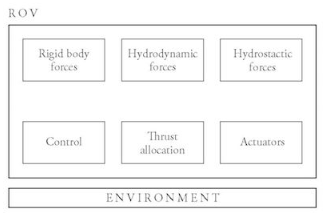On the use of time-domain simulation in the design of Remotely Operated Submergible Vehicles
DOI:
https://doi.org/10.25043/19098642.157Keywords:
Remotely Operated Vehicle Design, Time-domain simulationAbstract
Designing a Remotely Operated Vehicle (ROV) is a complicated task in which the design team deals with a considerable amount of uncertainty before the device is able to be tested at full scale. A way to cope with such uncertainty is to use simulation software to evaluate design concepts along the different levels of abstraction of the process. In this work, the use of aNySIM, the Maritime Research Institute Netherlands (MARIN) multibody time-domain simulation tool, as a part of the design process of an ROV is addressed. The simulation software is able to solve the equations of motion of the vehicle based on rigid body dynamics, including features such as hydrodynamics, hydrostatics, thrusters, thrust allocation, and PID control. Different simulation scenarios are proposed to evaluate different concept solutions to the design, including thruster parameters and distribution. The results are further used to select the concept solutions to be implemented in the final design.Downloads
Download data is not yet available.

Published
2017-09-15
How to Cite
Ramírez-Macías, J. A., Brongers, P., & Vásquez, R. E. (2017). On the use of time-domain simulation in the design of Remotely Operated Submergible Vehicles. Ciencia Y tecnología De Buques, 11(21), 41–49. https://doi.org/10.25043/19098642.157
Issue
Section
Scientific and Technological Research Articles
License
The authors who publish in this Journal certify that:
- The work submitted for publication in The Ship Science and Technology journal, was written by the author, given that its content is the product of his/her direct intellectual contribution.
- All data and references to material already published are duly identified with their respective credits and are included in the bibliographic notes and quotations highlighted as such.
- All materials submitted for publication are completely free of copyrights; consequently, the author accepts responsibility for any lawsuit or claim related with Intellectual Property Rights thereof, Exonerating of responsibility to The Science and Technology for the Development of Naval, Maritime, and Riverine Industry Corporation, COTECMAR.
- In the event that the article is chosen for publication by The Ship Science and Technology journal, the author state that he/she totally transfers reproduction rights of such to The Science and Technology for the Development of Naval, Maritime, and Riverine Industry Corporation, COTECMAR.
- The authors retain the copyright and transfer to COTECMAR the right of publication and reproduction of the work which will be simultaneously subject to the Creative Commons Attribution License (CC -BY) , which allows the license to copy, distribute, display and represent the work and to make derivative works as long as it recognizes and cites the work in the manner specified by the author or licensor.
- For more information about the Creative Commons Attribution License (CC -BY) and his use and scope, please visit the following web page https://creativecommons.org/licenses/by-sa/4.0/legalcode








